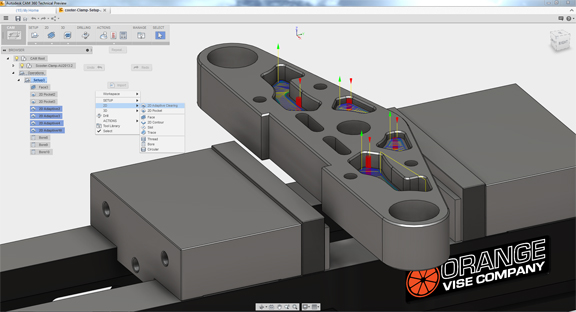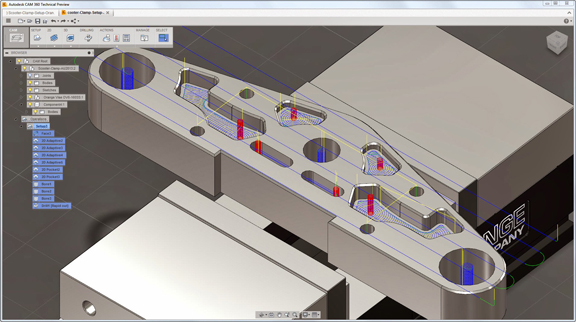December 9, 2013
At Autodesk University conference last week (The Venetian, Vegas, Nevada), Autodesk CEO Carl Bass struck a chord—literally. In the middle of his keynote address, he strummed on a custom-made guitar from Orphanage Guitars, designed in Autodesk Fusion 360 with his input and manufactured using CNC (computer-numeric-controlled) machining. Bass was not really playing the guitar; he synced his movements to the intro to Deep Purple’s “Smoke on the Water.” But his tribute and pledge to the computer-aided machine (CAM) industry must have been music to the ears of many from this often overlooked segment.
The design software titan’s aggressive pursuit of CAM technologies began with its 2012 acquisition of HSMWorks; it continues in the pending purchase of Delcam, now public knowledge. HSMWorks is known for, among other things, ease of use and tight integration with SolidWorks, a mechanical CAD modeler from Autodesk’s rival Dassault Systemes. After Autodesk acquired the product, HSMWorks continues to evolve and remains available as a SolidWorks add-on.
Brenda Discher, Autodesk’s VP of strategy and marketing, said, “The common gossip was, we’re going to build a HSMWorks product for Inventor and then kill off HSMWorks for SolidWorks. Well, only part of that was true.”
The company did develop Autodesk Inventor HSM Express, a counterpart to the free HSMXpress for SolidWorks. In July, Inventor HSM Express became a Beta product. Both the Express edition for Inventor and Xpress for SolidWorks are limited to 2.5-axis milling operations. They serve as gateway products to let users get a taste of the software’s ease of use. Higher end operations (3-axis, 5-axis, and so on) require a commercial license of HSMWorks.
Autodesk CAM 360, launched at last week’s Autodesk University (The Venetian, Vegas, Nevada), is the latest addition to the company’s CAM portfolio. It’s expected to be available next year. The company is pitching Autodesk CAM 360 as the all-in-one bundle that combines “CNC programming, simulation, and design with real-time collaboration and online project and data management.”
Whereas Autodesk Inventor HSM is designed to work in conjunction with parametric modeler Autodesk Inventor, Autodesk CAM 360 includes Autodesk Fusion, the company’s 3D direct modeler. The CAD-CAM linkage in these products promises to cut down on the steps and time required to move from 3D design to tool-path generation.
The cloud-hosted collaboration with social media-inspired functions is Autodesk’ gamble on its vision of how the next generation would want to work. For those who grow up in the start-up climate in the age of Facebook and Twitter, this style of project management is a natural evolution in data management. It’s expected to foster better communication between the designer and the shop floor machinists. But skeptics wonder if users might feel comfortable storing their intellectual data—specifically, the 3D design files—in the cloud.
CAM was once the de facto manufacturing method for anything large or small, but the emergence of 3D printers challenges its dominance. Among the hobbyists, tinkerers, homegrown inventors, and do-it-yourself (DYI) community, 3D printing emerges as a viable means to produce low volumes with complex shapes. But the introduction of affordable desktop milling machines, easy-to-use CAM software, and Autodesk’s initiatives may usher in a CAM Renaissance.
Just a few feet away from the Autodesk CAM showcase area in the exhibit hall, Shaun Mymudes, COO of SolidCAM, delightfully observed the increased foot traffic to CAM vendors’ booth, including his. Like HSMWorks, SolidCAM offers CAM packages for both SolidWorks (SolidCAM) and Autodesk Inventor (InventorCAM).
“Most people think of CAM as something they need to buy into—need to invest in and learn—so they may be reluctant to treat it as monthly rental,” Mymudes remarked.
On the one hand, Autodesk’s renewed interest in CAM is bound to spur its biggest competitors to take a closer look at other CAM software developers for possible partnerships or mergers. On the other hand, the company’s SaaS-style pricing for Autodesk CAM 360—roughly $75 to $150 per user per month—threatens to undercut the standard sales model.
Mymudes points out that his customers are not oppose to the idea of software subscription (instead of a perpetual license). He estimates 80% of SolidCAM users are on subscription. “If you have to pay $100 per month, in two years you would have paid for the cost of our 2.5D milling product,” said Mymudes.
For some CAM software vendors, competing with Autodesk may mean bolstering the type of value-added support and services. “We have nearly as many support people as we do sales people,” said Mymudes. “For us, support is number one. You have to wonder: What kind of support would you get at $100 per month? Will you get to talk to someone with 30 years of experience?”
According to Mymudes, InventorCAM also offers seamless integration with the CAD package. “With us, if you change something to your CAD model, that change flows down to the CNC equipment,” he said.
For prototypes with complex geometry, 3D printers offer the advantage of cost and speed. But for prototypes that must mimic the manufactured parts’ strength and durability in lab tests and stress tests, milling machines that can cut metal still serve as the best choice. And the rise of personal desktop milling machines is expected to attract hobbyists who have previously stayed away from CAM due to high cost of entry. (For more, read “A New Look at Subtractive Manufacturing,” September 2013.)
Autodesk has proven to have the organizational muscle to push certain professional products to the consumer and prosumer markets. CAM software makers—even those competing with Autodesk CAM 360—stand to benefit from Autodesk’s outreach campaigns.
Subscribe to our FREE magazine, FREE email newsletters or both!
About the Author
Kenneth Wong is Digital Engineering’s resident blogger and senior editor. Email him at [email protected] or share your thoughts on this article at digitaleng.news/facebook.
Follow DERelated Topics









